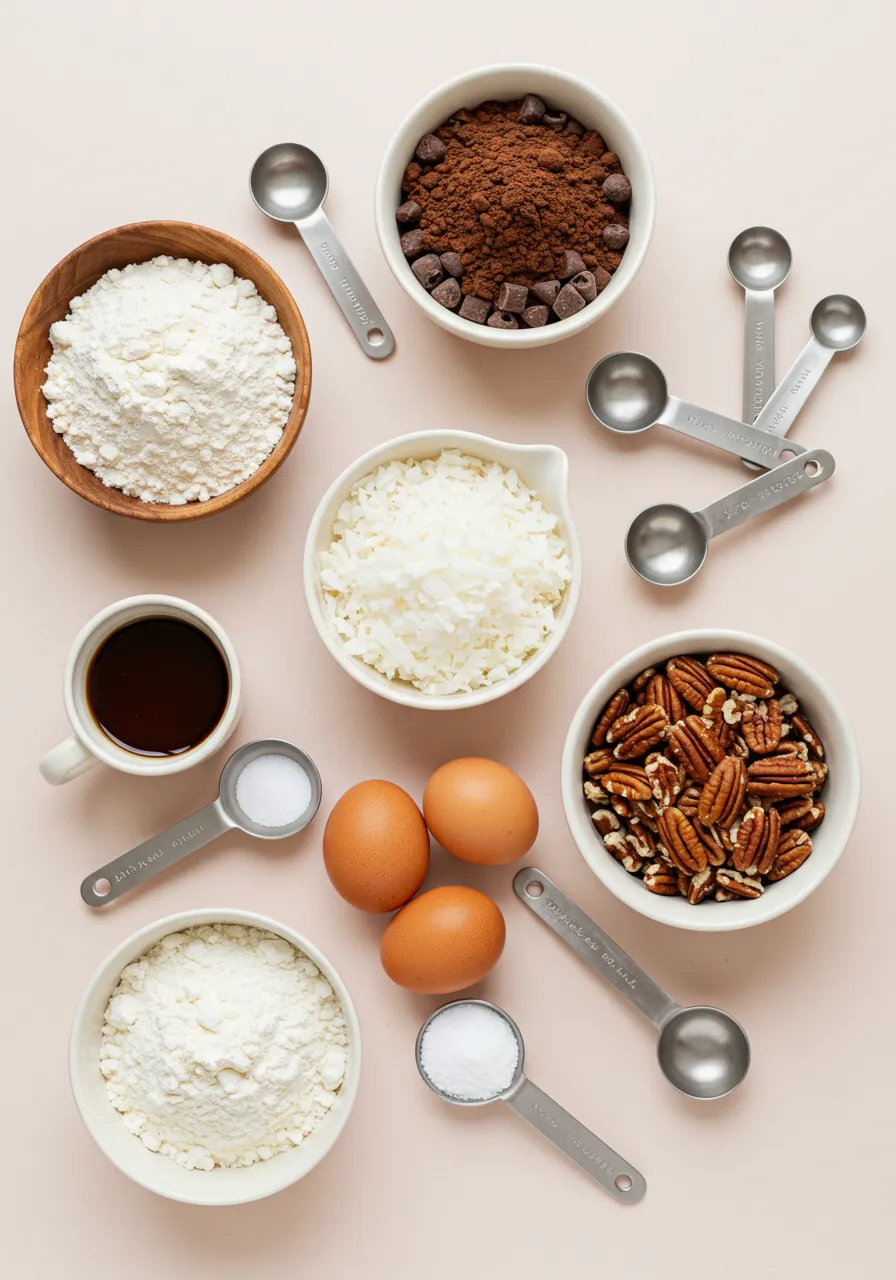Welcome to your new favorite indulgence—German Chocolate Cookies! If melty chocolate and the sweet combo of coconut and pecans are your thing, then you’re about to fall in love with this dessert. These cookies are everything a dessert lover dreams of: soft, chewy centers with molten chocolate pockets, a slightly crispy edge, and that iconic German chocolate flair. This isn’t just another cookie recipe—it’s a heartwarming fusion of nostalgic flavors and modern-day cookie perfection.
Whether you’re hosting a gathering, looking for a special bake-sale standout, or simply want to surprise your family with something delightfully decadent, this cookie delivers. Inspired by the traditional German chocolate cake but made easy and accessible, these cookies bring that same iconic flavor in a quicker, more snackable form. So grab your apron, and let’s bake something unforgettable together!
Key Benefits
Making German Chocolate Cookies from scratch offers more than just a homemade treat—they’re a little act of love, joy, and kitchen creativity. Here are some reasons why this recipe deserves a spot in your baking rotation:
- Classic Flavor in Cookie Form: You get all the nostalgic charm of German chocolate cake—rich chocolate, sweet coconut, and toasted pecans—but in a compact, chewy cookie that’s perfect for sharing.
- Beginner-Friendly: This recipe is easy enough for even novice bakers to follow, making it a fun weekend project or a great activity with kids.
- Texture Heaven: You’ll enjoy a delightful contrast—gooey centers, melty chocolate, and crunchy toasted pecans.
- Versatile for All Occasions: Whether it’s a cookie swap, holiday party, or simple weeknight treat, these cookies shine in any setting.
Baking these cookies also lets you explore variations like stuffing them with caramel for an extra layer of indulgence or using dark chocolate chunks for a more sophisticated flavor. If you’re curious about other ways to reimagine nostalgic treats, check out our popular cream cheese crescent roll appetizer—a hit for gatherings too!
Ingredients for German Chocolate Cookies
To make the best batch of German Chocolate Cookies, you’ll want to gather ingredients that blend tradition with delicious creativity. Here’s what you need:

- 2 1/4 cups of all-purpose flour—just the right amount to give your cookies the ideal bite.
- Unsweetened cocoa powder – 1/2 cup, to give that deep chocolate base.
- Baking soda – 1 tsp, for lightness.
- Salt – 1/2 tsp, to balance the sweetness.
- Unsalted butter – 1 cup (2 sticks), softened for creaming.
- Brown sugar – 1 cup, for that moist, caramelized texture.
- Granulated sugar – 1/2 cup, to sweeten and balance.
- Eggs – 2 large, room temperature.
- Vanilla extract – 2 tsp, for warmth.
- Semi-sweet chocolate chunks – 1 cup, for gooey chocolate pockets.
- Shredded sweetened coconut – 1 cup, to mimic the cake’s signature topping.
- Chopped pecans – 3/4 cup, toasted if desired, for nutty crunch.
Don’t skimp on quality ingredients here—using real vanilla and a good cocoa powder can take your cookies from good to “wow!” And if you’re on the hunt for great pecan pairings, our candied yams offer a delicious way to use up the rest of your nut stash!
Step-by-Step Instructions for German Chocolate Cookies
Here’s how to bring these cozy, chocolatey beauties to life:

- Get your oven ready by setting it to 350°F and laying parchment paper on two baking trays.
- Grab a bowl and whisk the flour, cocoa, baking soda, and salt together until everything looks nice and blended. Set aside.
- In a large bowl, whip the butter with both sugars until the mix is smooth and airy—around 2 to 3 minutes.
- Add the eggs one at a time, mixing well after each, then pour in the vanilla for that warm, homey flavor. Mix until well combined.
- Slowly work the dry mix into your wet ingredients until it forms a smooth cookie dough. Fold in chocolate chunks, coconut, and chopped pecans.
- Scoop and Space: Use a cookie scoop or spoon to drop dough balls (about 2 tbsp each) onto baking sheets, spacing about 2 inches apart.
- Bake and Cool: Bake 10–12 minutes, until the edges are set and centers are still soft. Give the cookies about 5 minutes to settle on the pan, then carefully transfer them to a cooling rack so they can firm up fully.
The result? A chewy, chocolatey masterpiece with bursts of sweet coconut and nutty surprises in every bite. If you enjoy baking with flair, try our chocolate chip cookie dough brownie bombs next—they’re decadence layered on decadence.
Smart Tips for German Chocolate Cookies
Want to take your cookies to the next level? Give these smart tricks a go:
- Toast Your Pecans: Toasting pecans in a dry skillet for 5 minutes brings out their flavor.
- Chill for Chewiness: Let your dough chill for 30 minutes before baking for thicker, chewier cookies.
- Add a Caramel Center: Scoop a bit of caramel into the center before baking to create a surprise gooey core.
- Go Dark: Substitute dark chocolate chunks if you love a more intense chocolate bite.
Want a dairy-free option? Swap in coconut oil and dairy-free chocolate. If you need them gluten-free, just swap in a one-to-one gluten-free flour mix—this dough handles changes really well.
Looking for more dessert twists? Our snowball cookies are a delicate, melt-in-your-mouth option that contrasts beautifully with these chewy treats.
Serving Suggestions for German Chocolate Cookies
These cookies are showstoppers, so why not give them the presentation they deserve?
- Serve Warm: A few seconds in the microwave revives that fresh-from-the-oven gooeyness.
- Pair with Ice Cream: Sandwich vanilla or coconut ice cream between two cookies for an indulgent treat.
- Holiday Platter Ready: Add them to your festive dessert table with churro cheesecake and fudge bars for variety.
- Gift-Worthy: Package them in clear treat bags with a ribbon for thoughtful homemade gifts.
You can even crumble them into a sundae or top a warm cookie with whipped cream for a cozy dessert moment. Cookies this special deserve the spotlight.
Trasted Resources for German Chocolate Cookies
- Learn about the health benefits of dark chocolate and why it’s good in moderation from Healthline.
- Serious Eats offers a great guide on how to toast nuts for maximum flavor.
- Bon Appétit shares expert insight on baking with coconut for flavor and texture perfection.
Conclusion
These German Chocolate Cookies are more than just dessert—they’re a warm hug in cookie form. With rich chocolate flavor, sweet coconut, and crunchy pecans, they bring comfort and joy to every bite. Whether you’re sharing with loved ones or savoring one with your evening tea, this recipe guarantees smiles all around.
Don’t wait for a special occasion—sometimes, the best moments are the ones we make sweet and spontaneous. Looking for more cozy recipes? Craving more cozy desserts? Check out our pumpkin dump cake recipe—it’s a crowd favorite.
Print
German Chocolate Cookies You’ll Absolutely Love
- Total Time: 27 minutes
- Yield: 24 cookies
- Diet: Vegetarian
Description
Rich, gooey, and irresistibly delicious, these German Chocolate Cookies blend deep cocoa, sweet coconut, and crunchy pecans into a crowd-pleasing classic.
Ingredients
- 2 1/4 cups all-purpose flour
- 1/2 cup unsweetened cocoa powder
- 1 tsp baking soda
- 1/2 tsp salt
- 1 cup unsalted butter (softened)
- 1 cup brown sugar
- 1/2 cup granulated sugar
- 2 large eggs
- 2 tsp vanilla extract
- 1 cup semi-sweet chocolate chunks
- 1 cup sweetened shredded coconut
- 3/4 cup chopped pecans
Instructions
- Preheat Oven: Set oven to 350°F and line baking sheets with parchment paper.
- Mix Dry Ingredients: Combine flour, cocoa, baking soda, and salt in a bowl.
- Cream Butter & Sugars: Beat butter, brown sugar, and granulated sugar until fluffy.
- Add Eggs & Vanilla: Mix in eggs one at a time, then vanilla.
- Combine Everything: Add dry ingredients to wet and mix. Fold in chocolate, coconut, and pecans.
- Scoop & Bake: Drop spoonfuls of dough on baking sheet and bake for 10–12 minutes.
- Cool: Let cool on the sheet for 5 minutes, then move to a rack.
Notes
Chill dough for chewier texture. Toast pecans for added flavor. Substitute walnuts if needed.
- Prep Time: 15 minutes
- Cook Time: 12 minutes
- Category: Dessert
- Method: Baked
- Cuisine: American
FAQs
Can I freeze German Chocolate Cookie dough?
Absolutely! Roll the cookie dough into small scoops and place them on a tray to freeze until solid. Once solid, store in a freezer-safe bag for up to 3 months. You can bake them straight from the freezer—just tack on an extra minute or two to the bake time.
What if I don’t have pecans?
Walnuts are a great substitute! You can also leave out nuts entirely for a nut-free version without sacrificing texture.
Can I make this dairy-free?
Yes! Use vegan butter and dairy-free chocolate chips. They still taste amazing and keep that soft, chewy bite you love.
How long will these cookies stay fresh?
Stored in an airtight container, they’ll stay soft and chewy for up to 5 days. Warm briefly before serving for that just-baked feel.
What pairs well with these cookies?
These cookies go great with a cold glass of milk, a cozy cup of coffee, or even a creamy coconut latte. Or, serve them alongside our blueberry French toast for a brunch dessert twist.

